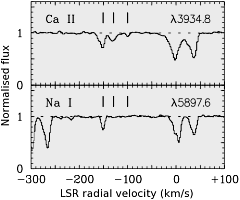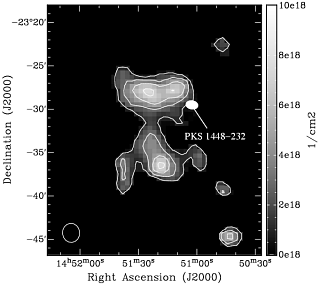Research
Ca ii and Na i absorbers in the Galactic halo
Introduction
 During the last decades, absorption and emission line measurements have demonstrated that the Milky Way is
surrounded by a complex, multi-phase gaseous halo. Embedded in a corona of million-degree gas, neutral and
ionised gas clouds move with high radial velocities $(|v| > 40~\mathrm{km \, s}^{-1})$ through the
Milky Way halo, giving rise to the population of intermediate- and high-velocity clouds (Wakker 2004).
While most of the recent HVC measurements have focussed on the distribution and properties of the large IVC
and HVC complexes, CHVCs, and highly-ionised HVCs, relatively little attention has been paid so far to the
abundance and distribution of neutral gaseous structures in the halo that have H i
column densities below the detection limit of the large 21-cm HVC surveys $($approximately
$10^{19}~\mathrm{cm}^{-2})$.
During the last decades, absorption and emission line measurements have demonstrated that the Milky Way is
surrounded by a complex, multi-phase gaseous halo. Embedded in a corona of million-degree gas, neutral and
ionised gas clouds move with high radial velocities $(|v| > 40~\mathrm{km \, s}^{-1})$ through the
Milky Way halo, giving rise to the population of intermediate- and high-velocity clouds (Wakker 2004).
While most of the recent HVC measurements have focussed on the distribution and properties of the large IVC
and HVC complexes, CHVCs, and highly-ionised HVCs, relatively little attention has been paid so far to the
abundance and distribution of neutral gaseous structures in the halo that have H i
column densities below the detection limit of the large 21-cm HVC surveys $($approximately
$10^{19}~\mathrm{cm}^{-2})$.
High-velocity Ca ii absorbers
Using archival data taken with the UVES spectrograph at the ESO Very Large Telescope (VLT), we detected high-velocity Ca ii and Na i absorption lines towards 8 out of 13 quasars, suggesting that the Milky Way halo contains a population of low column density neutral gas clumps. Many of the high-velocity Ca ii absorbers probably are associated with known HVCs. For the sightline towards the quasar PKS 1448−232 we carried out additional H i observations with the NRAO Very Large Array (VLA). The observations demonstrate that the Ca ii absorption is connected with low column density H i clumps with angular sizes of a few arcminutes and peak column densities of $\le 7 \times 10^{18}~\mathrm{cm}^{-2}$. Because of the unknown ionisation conditions and the fairly large beam size of the H i data of 2 arcmin, however, we are not able to determine the metallicity of the gas.
 With typical H i column densities of $\lt 10^{19}~\mathrm{cm}^{-2}$
and a complex velocity component structure, the properties of the Ca ii structures
in the Milky Way halo resemble those of strong Mg ii absorbers that are nearly always
found within an impact parameter of about $35 \, h^{-1}~\mathrm{kpc}$ of a luminous
galaxy (Ding et al. 2005; Bergeron & Boissé 1991). These strong Mg ii
systems are believed to sample both disk and halo gas in galaxies. The Ca ii systems
we found possibly represent the Galactic counterparts of halo Mg ii systems. The neutral
gas fraction probably is only a few percent or less, so that one would expect that the low column density
H i clumps in the halo have substantial ionised gaseous envelopes. Therefore it seems
likely that the detected Ca ii features also are related to the population of
highly ionised HVCs in the halo seen in C iv and O vi absorption
(Sembach et al. 2003).
With typical H i column densities of $\lt 10^{19}~\mathrm{cm}^{-2}$
and a complex velocity component structure, the properties of the Ca ii structures
in the Milky Way halo resemble those of strong Mg ii absorbers that are nearly always
found within an impact parameter of about $35 \, h^{-1}~\mathrm{kpc}$ of a luminous
galaxy (Ding et al. 2005; Bergeron & Boissé 1991). These strong Mg ii
systems are believed to sample both disk and halo gas in galaxies. The Ca ii systems
we found possibly represent the Galactic counterparts of halo Mg ii systems. The neutral
gas fraction probably is only a few percent or less, so that one would expect that the low column density
H i clumps in the halo have substantial ionised gaseous envelopes. Therefore it seems
likely that the detected Ca ii features also are related to the population of
highly ionised HVCs in the halo seen in C iv and O vi absorption
(Sembach et al. 2003).
Publications for further reading
- Low column density gas clumps in the halo of the Milky Way
Richter, P., Westmeier, T. & Brüns, C. 2005, A&A, 442, L49
(astro-ph/0509585) - Ca ii and Na i absorption signatures from extraplanar gas in the halo of the Milky Way
Ben Bekhti, N., Richter, P., Westmeier, T. & Murphy, M. T. 2008, A&A, 487, 583
(astro-ph/0806.3204)